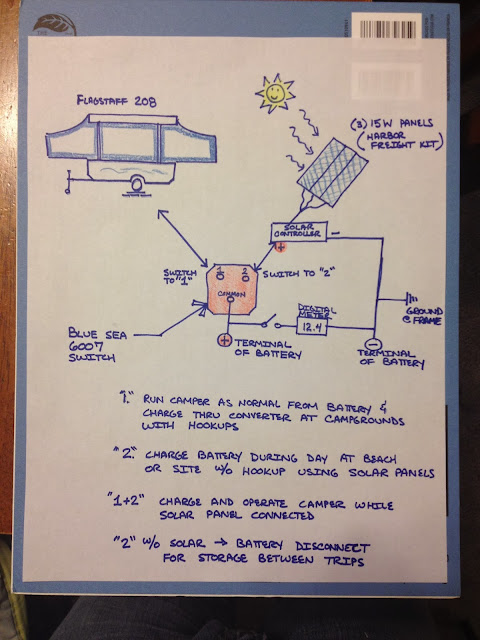So, as I sit here and type, we had 8 inches of snow a few days ago which crippled the area for a bit till they got a good chance to clean things up. The camper survived well, with the wind blowing most of the snow off of it in the day that followed. Now, it is freezing rain that is soaking into the snow, freezing on top, freezing the sidewalks,... and making it miserable.
So,.. why not think about the camping season and what we can do this year!
I managed to score a great deal on the Harbor Freight 45W Solar Panel system with charge controller on New Years Day during the big sale. Lowest price that I have seen for it when I used the 25% coupon too! That got me thinking on a rainy day like this, what is the best way to hook everything up for our camper and our needs. The Solar system will only be used a few times a year when we dry-camp out back, camp on the beach of Asseteague Island, or find another new place to go. The rest of the time we will have the opportunity to plug into the campground shore power and have the converter charge our deep cycle battery.
I read a bit about how the systems work and I wanted to add a way to disconnect the power from the battery to the camper as well, so that when sitting for a few weeks between trips the LP and CO detectors can't draw on the battery. Doesn't seem like much, but after 3-4 weeks it makes a difference when you go to power lift the camper roof.
Bring in the Blue Sea battery switch. This is a marine grade switch used on boats to select between two points of battery source, or both, and would be a perfect fit I think for our objective. If I wire the "common" terminal as the 12V battery, then option 1 can be the camper and option 2 can be the solar array. If we need, I can even select "1+2" and have the camper and solar array connected to the battery at once.
Typically, we will operate at Position 1, which gives us all the features we have connected now as if we are directly connected to the terminal. Battery is connected to the Camper Fuse system and Converter. If at a campground with hookup, the battery can be maintained thru the converter in the camper and charged.
Parking for the weeks between trips, I can select Position 2, but NOT have the solar system connected. This would effectively be my battery disconnect position.
Camping at Asseteague Island for 4 days with no hookups at the site, we can be in Position 2 and connect the solar controller and array to charge and maintain the battery during the day. Set to Position 1, the camper lighting, fan, and water pump can be active when we are in the camper in the evening and the solar array disconnected.
I still have to read up, but doesn't seem to be any reason why we can't be in Position "1+2", when connected to the solar array (not connected to shore power at a campground), so that the water pump can be run and the battery can have a load on it / charge on it at the same time.
In order to keep tabs on the battery voltage, a simple digital LCD volt meter will be wired across the battery terminals with a single pole switch so that I can turn on / off the meter to see the voltage of the battery. It is always a good idea to keep an eye on the voltage, but you also have to remember to read it at rest, which may mean an hour after disconnecting the solar array. You can read it while charging, but it is effectively reading the solar panel voltage output/charge, and not the actual state of the battery.



No comments:
Post a Comment